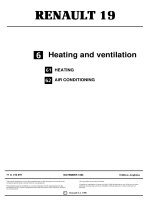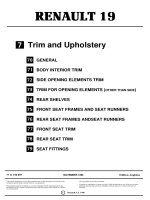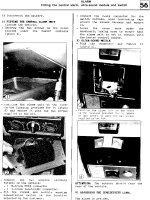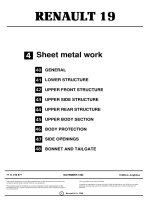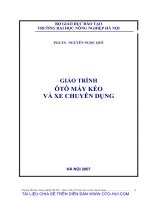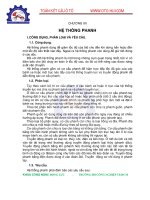Xe ô tô hyundai excel toàn tập hyundai excel - P4
Bạn đang xem bản rút gọn của tài liệu. Xem và tải ngay bản đầy đủ của tài liệu tại đây (2.23 MB, 79 trang )
BODY (INTERIOR
AND EXTERIOR)
Return To Main Table of Contents
GENERAL
.................................
2
BODY PANELING
.............................
7
BODY DIMENSIONS
............................
14
HOOD ....................................
19
RADIATOR GRILLE
............................ 20
BUMPER .....................................
21
FENDER .........................................
22
WINDSHIELD
..........................................
24
REAR GLASS
..........................................
29
QUARTER FIXED GLASS
.............................
31
QUARTER SWIVELLING GLASS
......................
34
FRONT DOOR
............................36
REAR DOOR
.................................. 42
TRUNK LID
......................................
47
TAIL GATE
......................................48
BACK PANEL MOULDING
...........................
51
INTERIOR TRIM
...................................53
CRASH PAD
......................................
58
CONSOLE
....................................... 64
HEAD LINING
...................................... 65
FRONT SEAT ........................................
67
REAR SEAT
..................................... 68
SEAT BELT .................................70
PASSIVE SEAT BELT .............................
72
SUNROOF ......................................74
GENERAL
GENERAL
SPECIFICATIONS
Hood
Type
Front door
Construction
Regulator system
Locking system
Rear door
Construction
Regulator system
Locking system
Quarter swivelling window
Front hinged, rear opening type
Front hinged, sash construction
X-arm type
Pin-fork system
Front hinged, sash construction
X-arm type
Pin-fork system
Type
Tailgate
Type
Trunk lid
Type
Glass thickness
Windshield glass
Quarter fixed glass
Front hinged, rear opening type
Inner hinged, gas damper type
mm (in.)
Torsion bar type
Zone tempered clear
Laminated clear, tinted
Full tempered clear
5 (0.20)
5.4 (0.21)
5 (0.20)
3.2 (0.13)
Tailgate window glass
4.0 (0.16)
Rear window glass
3.5 (0.14)
Quarter swivelling glass
4.0 (0.16)
Distance between door upper side hinge
Front door 348 mm (13.9 in.)
and lower side hinge
Rear door 323 mm (12.9 in.)
Seat travel (rearmost - - - foremost)
180 mm (7.2 in.) by 20 mm steps.
60-2
GENERAL
TIGHTENING TORQUE
Nm
kg.cm
Ib.ft
Front and rear doors
Door hinge to body
Door hinge to door
Tailgate
Tailgate hinge to body
Tailgate hinge to tailgate
Ball stud to body
Ball stud to tailgate
Hood
Hood latch to body
Hood striker to hood
Hood stay rod to hood
Hood hinge to body
Hood hinge to hood
Seat
Front seat to floor
Rear seatback striker
Rear seatback tilting bracket
Rear seat cushion
Seat belt
Front seatbelt retractor to center pillar
Rear seatbelt anchorage
Passive seat belt anchorage
36-42
360-420
26-30
13-26 130-260
9-19
28-35 280-350
20.2-25.3
28-35 280-350
20.2-25.3
22-27
220-270
16-19.5
22-27
220-270
16-19.5
7-9
70-90
5-6.5
7-9
70-90
5-6.5
7-9
70-90
5-6.5
22-27
220-270
16-19.5
22-27
220-270
16-19.5
15.4-19.0
15.4-19.0
15.4-19.0
15.4-19.0
30-44 306-448
22-32.5
30-44
306-448
22-32.5
40-45
400-450
29-33
154-190
154-190
154-190
154-190
11.0-13.5
11.0-13.5
11.0-13.5
11.0-13.5
60-3
GENERAL
SPECIAL TOOLS
60-4
GENERAL
TROUBLESHOOTING
Symptom
Sunroof
Water leaks
Wind noise
Roof lid makes noise
when moved
Motor runs but lid does
not move or moves only
halfway
Noise in motor (Clutch
slipping noise made in
motor when lid is fully
opened or closed is not
unusual noise.)
Door glass fails to operate
up and down
Door glass operates up
and down hardly
Probable cause
Dust accumulated in drainage of housing
assembly
Clogged drain pipe
Broken or dislocated drain pipe, defective
or cracked clip
Deteriorated roof lid weatherstrip
Excessive roof lid-to-body clearance and
improperly fitted weatherstrip
Loose or deformed deflector
Foreign matter lodged in guide rail
Loose guide rails and lid
Foreign matter lodged in guide rail
Incorrect engagement of motor pinion with
drive cable
Decrease in clutch slipping force of motor
Increased lid sliding resistance or interference
of lid with drive cables, weatherstrip, etc. due
to maladjustment of lid
Incorrect engagement of motor pinion with
drive cable
Worn or damaged motor pinion bearing
Worn or deformed drive cable
Dismount window glass regulator
Detached sash
Broken sash
Collapsed sash
Collapsed window glass regulator arm
Broken window glass regulator
Improper window glass position
Collapsed sash
Collapsed window regulator arm
Broken window handle regulator
Remedy
Keep off dust from inside of
‘drain pipe
Blow air into drain pipe to
remove dust
Check pipe installation and flange
contact
Replace
Adjust
Retighten or replace
Check drive cable and guide rails
for foreign matter
Retighten
Check drive cable and guide rails
for foreign matter
Check for loose motor installation
and damaged pinion
Adjust
Adjust or replace
Check pinion installation and
retighten motor
Replace motor assembly
Replace
Adjust
Attach
Replace
Repair or replace
Repair or replace
Replace
Adjust
Repair or replace
Repair or replace
Replace
60-5
GENERAL
Symptom
Wind noise around door
Wind noise around liftgate
Probable cause
Weatherstrip not holding firmly
Improperly installed weatherstrip or setting
of weatherstrip
Improperly closed door
Improperly fit door
Improper clearance between door glass
and run channel
Deformed door
Weatherstrip not holding firmly
Improperly installed weatherstrip or setting
of weatherstrip
Uneven clearance between body and liftgate
Deformed liftgate
Remedy
Adjust fit of door
Repair or replace
Adjust
Adjust
Adjust
Repair or replace
Adjust fit of liftgate
Repair or replace
Adjust
Repair or replace
60-6
BODY PANELING
BODY PANELING
COMPONENTS
3-Door model
1. Panel assy, radiator support
2. Panel assy, fender apron
3. Panel assy, cowl top front
4. Panel assy, cowl inner lower
5. Panel assy, cowl top outer
6. Panel assy, cowl side inner
7. Panel assy, front door
8. Panel assy, dash complete
9. Panel assy, cowl side inner upper
10. Panel, roof
11. Rail assy, roof front
12. Rail assy, roof center
13. Rail assy, roof side
14. Panel assy, front floor
15. Pillar assy, front
16. Member, front floor side
17. Panel assy, side sill
18. Member assy, rear floor
19. Panel assy, rear floor
20. Panel assy, quarter outer
21. Panel assy, quarter inner
22. Panel assy, back
23. Door, fuel filler
24. Front side member outer
60-7
BODY PANELING
COMPONENTS
1. Panel assy, radiator support
2. Panel assy, fender apron
3. Panel assy, cowl top front
4. Panel assy, cowl inner lower
5. Panel assy, cowl top outer
6. Panel assy, cowl side inner
7. Panel assy, front door
8. Panel assy, dash complete
9. Panel assy, cowl side inner upper
10. Panel, roof
11. Rail assy, roof front
12. Rail assy, roof center
13. Rail assy, roof rear
14. Panel assy, rear door
15. Panel assy, front floor
16. Pillar assy, front
17. Member, front floor side
18. Panel assy, side sill
19. Member assy, rear floor
20. Panel assy, rear floor
21. Pillar assy, center
22. Panel assy, quarter inner
23. Panel assy, quarter outer
24. Panel assy, back
25. Door, fuel filler
26. Panel assy, rear package tray
27. Frame, rear window opening outer
28. Frame, rear window opening inner
29. Front side member outer
60-8
BODY PANELING
COMPONENTS
5-Door model
1. Panel assy, radiator support
2. Panel assy, fender apron
3. Panel assy, cowl top front
4. Panel assy, cowl inner lower
5. Panel assy, cowl top outer
6. Panel assy, cowl side inner
7. Panel assy, front door
8. Panel assy, dash complete
9. Panel assy, cowl side inner upper
10. Panel, roof
11. Rail assy, roof front
12. Rail assy, roof center
13. Rail assy, roof rear
14. Panel assy, rear door
15. Panel assy, front floor
16. Pillar assy, front
17. Member, front floor side
18. Panel assy, side sill
19. Member assy, rear floor
20. Panel assy, rear floor
21. Pillar assy, center
22. Panel assy, quarter inner
23. Panel assy, quarter outer
24. Panel assy, back
25. Door, fuel filler
26. Front side member outer
60-9
BODY PANELING
CROSS-SECTIONAL VIEW
5-Door model
3-Door model
60-10
BODY PANELING
4-Door model
Section A-A
Section D-D
Section B-B
Section E-E
Section C-C
Section I-I
60-11
BODY PANELING
Section J-J
Section M-M
Section P-P
Section S-S
Section K-K
Section L-L
Section N-N
Section Q-Q
Section T-T
Section W-W
Section O-O
Section R-R
Section X-X
60-12
BODY PANELING
Section Z-Z
Section Y-Y
Section A'-A'
Section B’-B’
1. Panel assy, hood
2. Panel assy, radiator support
3. Panel assy, fender
4. Pillar assy, front
5. Panel assy, front door
6. Panel assy, roof
7. Pillar assy, center
8. Panel assy, rear door
9. Panel assy, side sill
10. Panel assy, quarter
11. Panel assy, wheel house
12. Panel assy, tailgate
13. Panel assy, back
14. Panel assy, cowl top
15. Rail assy, roof side
16. Panel assy, trunk lid
17. Panel assy, rear package tray
60-13
BODY DIMENSIONS
BODY DIMENSIONS
3/5 DOOR
I
60-14
BODY DIMENSIONS
4 DOOR
60-15
BODY DIMENSIONS
Rear towing hook mounting hole and
bumper mounting hole (ø 16)
60-16
BODY DIMENSIONS
3/4/5 DOOR
BODY DIMENSIONS
3/5 DOOR
4 DOOR
Tailgate hinge mounting hole (ø 12)
Tailgate striker mounting hole (ø 9)
Trunk lid hinge mounting hole (ø 6.3)
Trunk lid striker mounting hole (ø 9)
60-18
HOOD
HOOD
COMPONENTS
ADJUSTMENT
1. Adjust hood in forward/rearward and left/right directions.
Loosen the hood side hinge bolts to adjust.
2. Adjust front edge of hood in vertical direction by adjusting the
hood stop adjusting bolts.
3. Loosen the mounting bolts to adjust the hood latch.
NOTE
Apply chassis grease to the sliding part, the rotating part and
the spring of the hood latch.
60-19
RADIATOR GRILLE
RADIATOR GRILLE
COMPONENTS
REMOVAL
1.
Remove the radiator grille by removing the radiator grille mount-
ing fastener.
60-20
BUMPER
REMOVAL
1. Remove the bumper assembly-to-body bolts.
2. Remove the bumper cover-to-bumper stay nuts.
60-21
FENDER
FENDER
COMPONENTS
TORQUE: Nm (kg.cm, ft.lbs.)
REMOVAL
1. Remove the position lamps and side marker lamps.
2. Remove the mud guards.
3. Remove the front wheel guards and front wheel end guards.
60-22
FENDER
3. Remove the antenna.
4. Remove the fender mounting bolts and remove the fender.
NOTE
Be careful to avoid damaging the paint.
INSTALLATION
1. Installation is the reverse of removal.
NOTE
When installing the fenders, apply drying sealant between
the fenders and the body panels, so that there are no gaps
when the fenders are mounted.
60-23
WINDSHIELD
WINDSHIELD
COMPONENTS
REMOVAL
1. To remove the windshield, first remove the following parts:
(a) Inside rear view mirror and pillar trims.
(b) Wiper arms.
(c) Cowl top cover.
(d) Side mouldings and upper moulding.
NOTE
Apply protective tape along the edge of the dashboard and
body.
2. Using an awl, make a hold through the windshield sealant.
3.
Push piano wire through the hole and wrap end around a piece
of wood or using special tool, Sealant Cut-out Tool (09861-
31100).
4. With an assistant, carefully cut ‘through adhesive material by
pulling wire along windshield alternately from inside and out-
side the car.
CAUTION
Hold the piano wire as close to the glass as possible to pre-
vent damage to the body and dashboard.
60-24
WINDSHIELD
5. Make mating marks on the glass and body if the glass is to be
reinstalled.
NOTE
Use chalk or equivalent to make mating marks on the glass
and body.
6. Take out the windshield glass with special tool, Glass Holder
(09861-31400).
INSTALLATION
1. Using a cutter knife or special tool, Sealant Cutting Blade
(09861-31200). scrap the old sealant smoothly to a thickness of
about 2 mm on the bonding surface around the entire wind-
shield flange.
2. Finish the flange surfaces so that they are smooth.
CAUTION
Be careful not to remove more adhesive than necessary, and
also not to damage the paintwork on the body surface with
the knife. If the paintwork is damaged, repair the damaged
area with touch-up paint.
3. Clean the body bonding surface with a sponge dampened in
alcohol.
4.
Install the cowl top cover mounting retainers and washers at the
locations as shown in illustration.
5. Center a new windshield in the opening.
‘Mark the location by scribing lines across the glass and body
with a grease pencil at the four points as shown.
60-25


